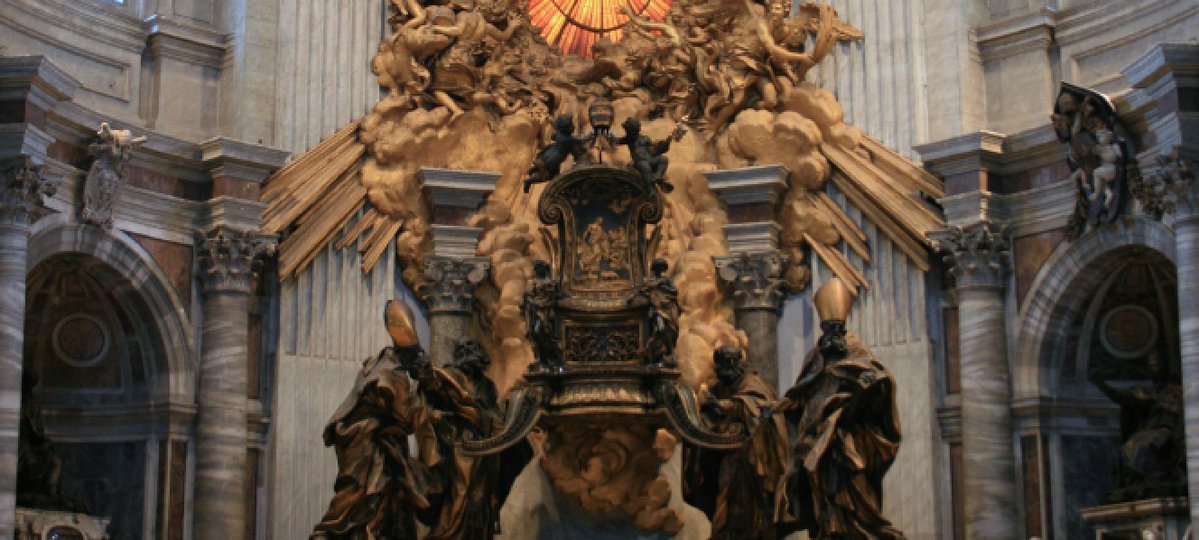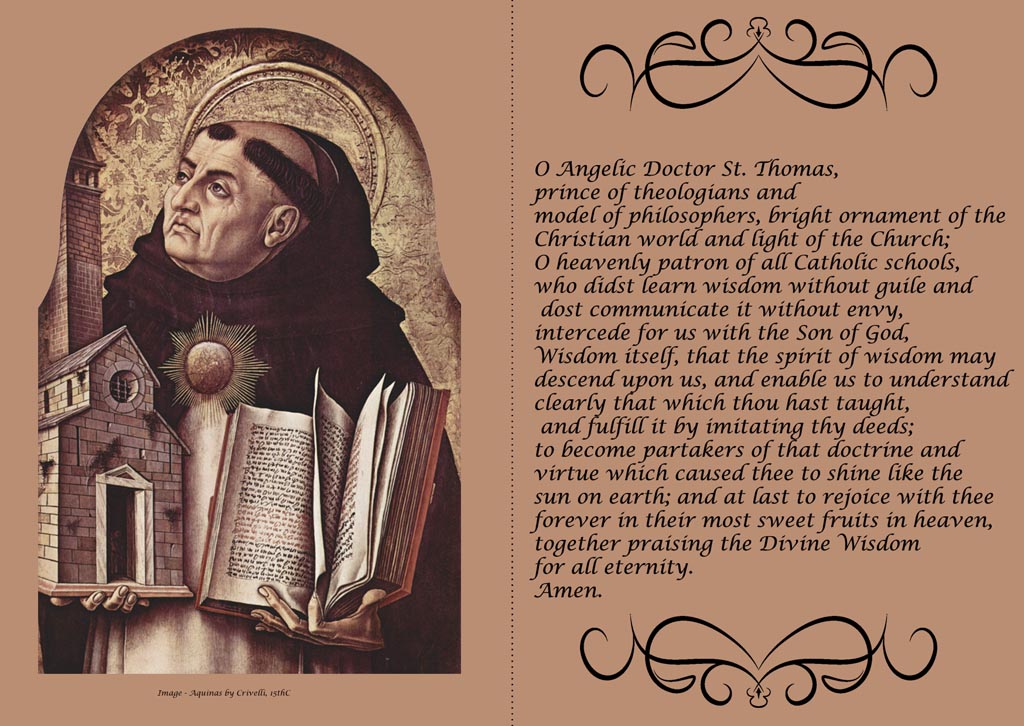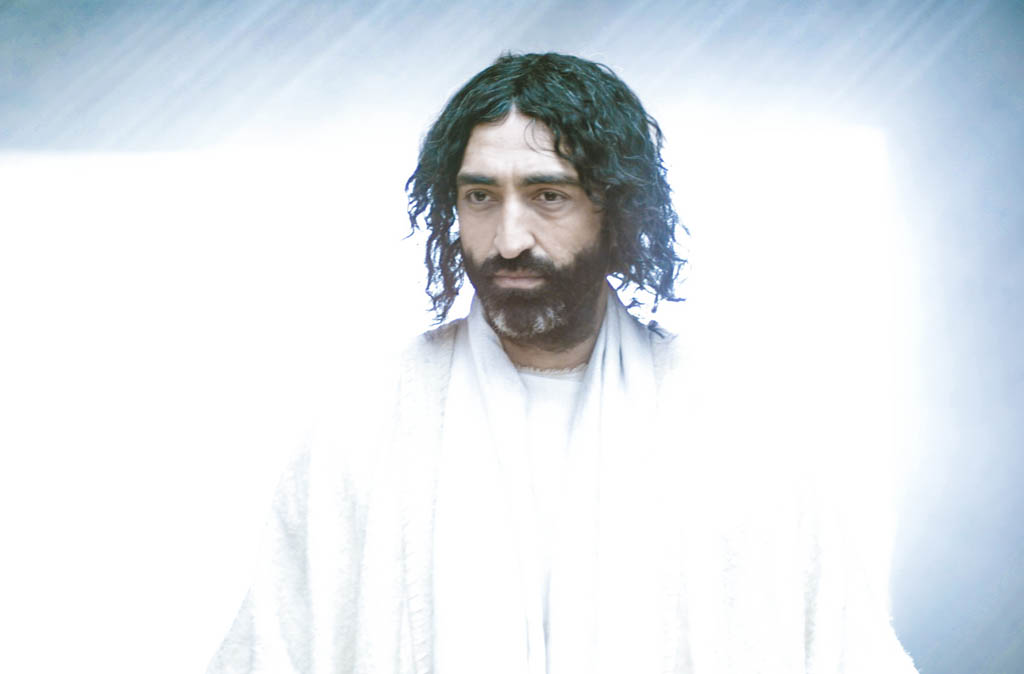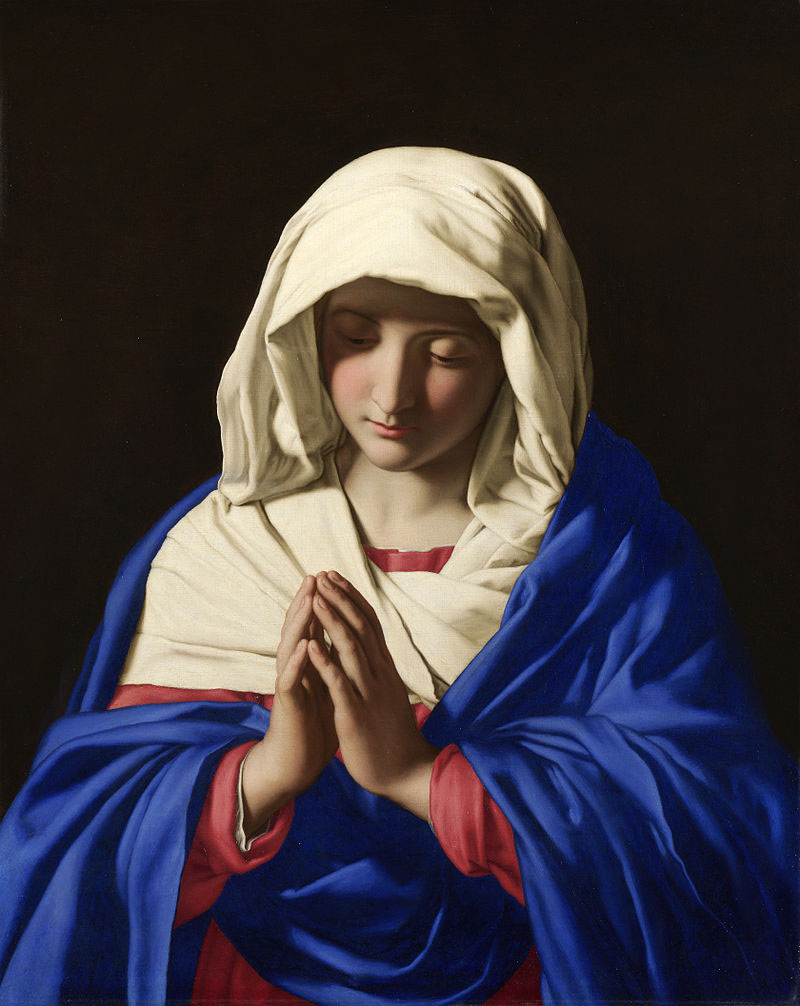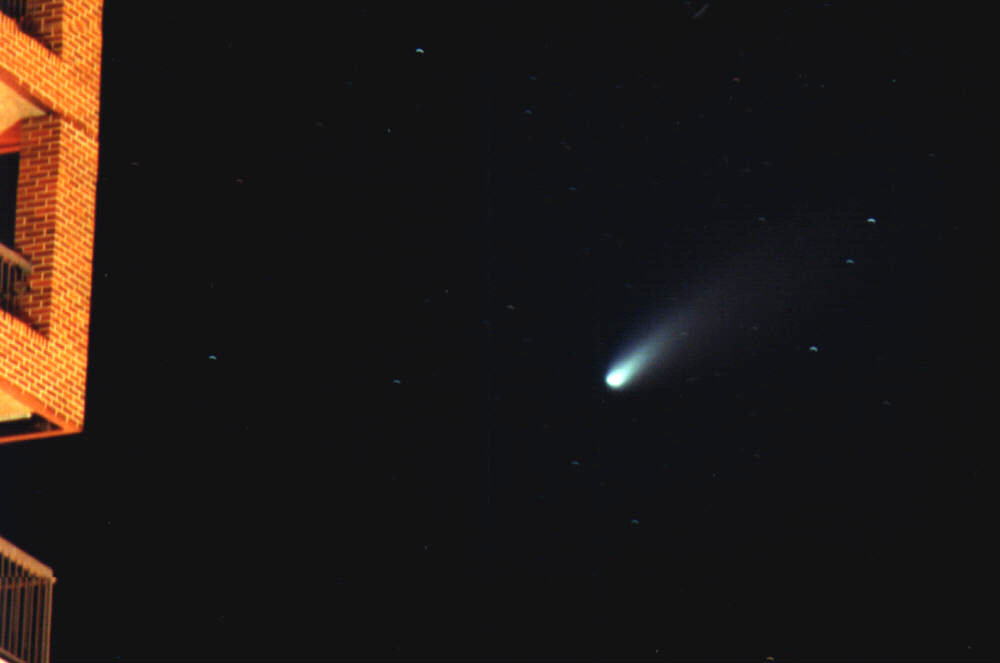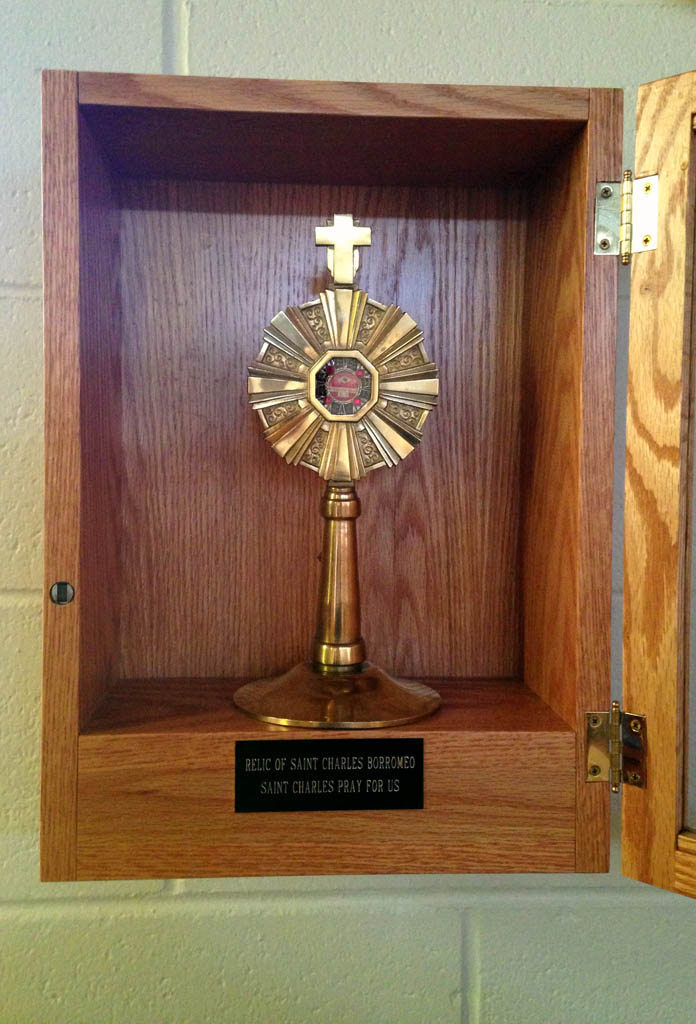The Flos Carmeli – Flower of Carmel
Devotion to Our Lady under this title is perhaps one of the oldest in the Church; in fact, it may have been started within her own lifetime. It is believed that she visited on Mount Carmel the hermetical spiritual descendants of Prophet Elias and the “Sons of the Prophet,” who lived a life of solitary prayer and meditation on that mountain. These men had heard and received the preaching of St. John the Baptist, and after Pentecost embraced the faith of Our Lord Jesus Christ. Mary was always a spiritual inspiration to these men, assisting them with her interest and prayers, which gave them a close tie to her, so much so that they built a chapel in her honor, believed to be the first Marian Chapel in the world. They became known as the Brothers of the Blessed Mary of Mount Carmel, and the Carmelite Order sees its origin in these early monastics.
The Feast of Our Lady of Mount Carmel is known to many Catholic faithful as the “scapular feast,” associated with the Brown Scapular of Our Lady of Mount Carmel, a devotional sacramental signifying the wearer’s consecration to Mary and affiliation with the Carmelite Order. A tradition first attested to in the late 14th century says that Saint Simon Stock, an early prior general of the Carmelite Order, had a vision of the Blessed Virgin Mary in which she gave him the Brown Scapular which formed part of the Carmelite habit, promising that those who died wearing the scapular would be saved.

From the National Catholic Register:
” New research indicates that the Shroud of Turin shows signs of blood from a torture victim and undermines arguments that the reputed burial shroud of Jesus Christ was painted. Very small particles attached to the linen fibers of the shroud “have recorded a scenario of great suffering, whose victim was wrapped up in the funeral cloth,” said Elvio Carlino, a researcher at the Institute of Crystallography.”
Read the article on the National Catholic Register’s Website.
The complete scientific paper with its conclusions may be read at: “Atomic resolution studies detect new biologic evidences on the Turin Shroud”
This is the one of the oldest of all novenas. It commemorates the nine days between the Ascension of Our Lord and the descent of the Holy Ghost on the first Pentecost Sunday. During this time Our Lady and the twelve Apostles prayed in the Cenacle for the coming of the Paraclete. Our Lord Himself instituted this novena, and it is celebrated every year by the whole Church.
This novena has two intentions:
1 – That like the Apostles, we pray that the Holy Ghost will come into our lives and set the Church and faithful on fire with true Apostolic zeal.
2 – That on Pentecost Sunday every year, we renew our consecration to Jesus through Mary as prescribed by Saint Louis Marie de Montfort. On this solemn occasion, we pray that we may be true to our consecration and live it ever more faithfully during the year to come. Every member of the Crusade should feel that he or she has a special obligation to make this novena.
A printable copy of the Novena is available HERE:
The Diocese of Calgary has just released the list of2017 Pastoral Moves and Assignments. Our own Fr.Nathan stays with us as Pastor, and has also been assigned to the Office of Diocesan Master Of Ceremonies. Please pray for him as he takes on this new role.
The full list of moves and assignments is available here as a PDF – Diocese of Calgary Pastoral Moves 2017
The Shroud of Turin has always fascinated. Is it merely, as secular society would have it, a man made painting? Or is it, as we,the faithful hold it to be, the actual image of Christ, imprinted on his burial cloth at the moment of His Resurrection?
In 2004, Dame Isabel Piczek—a Hungarian trained particle physicist and internationally renowned monumental artist—believed she had uncovered hard, scientific evidence that Jesus Christ did, in fact, rise from the dead. She became fascinated by the total absence of distortion of the Shroud image, a physical impossibility if the body had been lying on solid rock. She strongly suggests, in her theory, that the image of Jesus was projected as a quantum hologram onto the cloth as His body underwent the process of Resurrection.
In her words:
“The phenomenon of the image brings us to a true event horizon, a moment when all of the laws of physics change drastically. The entire Resurrection process is akin to the Big Bang creation of the universe when something was created from nothing. You can read of the science of the Shroud, such as total lack of gravity, lack of entropy no time, no space—it conforms to no known law of physics….the image was created in an infinitesimally small fraction of a second and its formation was absent of the effects of gravity.”
Dame Piczek said of the complicated physics behind the image :
“At the moment of the Resurrection quantum time collapsed to absolute zero (time stopped moving) in the tomb of Christ, the two event horizons (one stopping events from above and the other stop-ping the events from below at the moment of the zero time col-lapse) going through the body get infinitely close to each other and eliminate each other (causing the image to print itself on the two sides of the Shroud). In general relativity, an event horizon is a boundary in space-time, most often an area surrounding a black hole, beyond which events cannot affect an outside observer. Light emitted from beyond the horizon can never reach the observer, and anything that passes through the horizon from the ob-server’s side appears to freeze in place. Attempting to make an object approaching the horizon re-main stationary with respect to an observer requires applying a force whose magnitude becomes unbounded (becoming infinite) the closer it gets. According to the nature of event horizons the dead body must have left its image on the two surfaces of the event horizons. At the time of the explosion (when time stopped) of the event horizons these images were ejected onto both sides of the Shroud, with the body hovering parallel to the event horizons. This explains why the image shows a dead man, not the risen body, and also explains why the image is negative (went from a positive body image to the negative image like a camera film negative). This indicates how the image got onto the cloth.”
Crucifixion was the ultimate method of capitol punishment in the Roman Empire, reserved for the worst offenses against the state, reserved for slaves, foreigners, revolutionaries, and vile criminals. The only time a Roman citizen was ever crucified was for desertion from the army.
Crucifixion was intended to be a public death, a warning, carried out so as to cause the most humiliation, and the most extreme amounts of pain.
In an article entitled “The facts of crucifixion” published at The Catholic Education Resource Centre, Robert Gidley examines the Crucifixion of Our Lord, with a mind to explain just how horrible a death crucifixion was.
The Lenten Retreat Series – The Seven Last Words of Christ will be available as videos and transcripts on Swords of Truth. Links below will be updated as new videos become available.
- 7 Last Words of Christ: 1st Word by Fr. Jerome
- 7 Last Words of Christ: 2nd Word by Fr. Nathan
- 7 Last Words of Christ: 3rd Word by Fr. Jonathan
- 7 Last Words of Christ: 4th Word – by Fr. Jerome
- 7 Last Words of Christ: 5th Word – by Fr. Nathan
- “Tre Ore” – 6th and 7th Last Words of Christ – A SPECIAL EVENT
Fr. Cristino’s Lenten series: “Eagerly Have I Desired to Share this Meal with You: Understanding the Holy Sacrifice of the Mass” is a six part lecture series explaining the nature and structure of the Mass. These lectures have been produced as a video series and may be viewed at the following links:
Understanding the Mass, Week 1 of 6, Basic Principles of Liturgy
Understanding the Mass, Week 2 of 6, Preparing for Mass & Introductory Rites
Understanding the Mass, Week 3 of 6, Liturgy of the Word
Understanding the Mass, Week 4 of 6, Liturgy of the Eucharist, Part 1
Understanding the Mass, Week 5 of 6, Liturgy of the Eucharist, Part 2
Understanding the Mass, Week 6 of 6, Concluding Rites and Reflection
From Fr. Nathan:
In October 2014, Pope Francis remarked that “in this generation, like so many others, people have been led to believe that the devil is a myth, a figure, an idea,the idea of evil. But the devil exists and we must fight against him.” Many seek to deny the devil’s existence and in doing so make themselves more susceptible to his influence, most especially his ability to tempt us to commit sin. As we begin our Lenten Fast, let us be
aware that the devil, who St. Peter said “is like a roaring lion, looking for someone to devour” (1 Pet 5:8) will look for opportunities to disrupt and frustrate our resolve to pray, do penance and give alms in the coming 40 days.
Let us ask Our Lord, His Holy Mother and the Holy Archangel Michael to be our safeguard against the wickedness and snares of the devil, trusting that they will assist us when we are tempted and deliver us from the power of the Evil One.
In an article on the Word on Fire blog, Fr.Steve Grunow explains…
“Today the Church celebrates a curiously named feast called “the Chair of Saint Peter.” The “chair” references an actual piece of furniture that is encased in a monumental sculpture by Bernini located in the apse of St. Peter’s Basilica.”
The complete article may be read HERE:
Salt and Light TV interviewed Bishop McGrattan on his upcoming move to Calgary.
You have probably noticed that there are now veils over top of the tabernacles in our two church buildings. In both the Old and New Testaments, veils were placed in the vicinity of places and liturgical items of notable sanctity and importance. In the Book of Exodus, we read that when the People of Israel built their tent or tabernacle sanctuary in the desert, the holiest part of the tent, where the Ark of the Covenant resided, was concealed behind a veil or curtain to indicate the utmost sanctity of this portion of the tent. When the Temple was constructed in Jerusalem, the back portion of the Temple, known as a Holy of Holies, was hidden behind a large curtain. The Holy of Holies was understood to be the throne room of God and the holiest place on earth. When Christians began to construct churches, it became the custom to place a veil overtop of the tabernacle where the Body of Christ was kept. Since the Holy Eucharist is the Church’s greatest treasure and the great sign and reality of God’s Holy Presence among us, it is fitting that our tabernacles are concealed beneath a veil to remind us that Jesus Christ is mysteriously in our midst, inviting us spend time with Him and speak to Him in the silence of our hearts. In addition, the tabernacle veils also help us to remember what liturgical season we are currently celebrating. The colours of the tabernacle veils correspond to the following liturgical seasons:
Green: Weekdays and Sundays of Ordinary Time.
White: Weekdays and Sundays of Christmas and Easter, in addition to memorials, feasts and solemnities of Our Lord Jesus Christ, The Blessed Virgin Mary and the Holy Saints and Angels.
Purple: Weekdays and Sundays of Advent and Lent.
Red: Palm Sunday, Pentecost and the feasts and solemnities of the Holy Apostles and Martyrs.
Fr.Nathan
On October 20th, 2016, one of the most exciting events in centuries took place: the opening of the marble slab guarding the place tradition claims was the tomb of Jesus, inside the Basilica of the Holy Sepulcher in Jerusalem. What was found by archaeologists? Read the full account in an article entitled:
The Holy Sepulcher: Archaeology says the Evangelists were right !
Thomas Aquinas is the preeminent spokesman of the Catholic tradition of reason and of divine revelation. He is one of the great teachers of the medieval Catholic Church, honored with the titles Doctor of the Church and Angelic Doctor. His greatest contribution to the Catholic Church is his writings. The unity, harmony and continuity of faith and reason, of revealed and natural human knowledge, pervades his writings. One might expect Thomas, as a man of the gospel, to be an ardent defender of revealed truth. But he was broad enough, deep enough, to see the whole natural order as coming from God the Creator, and to see reason as a divine gift to be highly cherished.
Read what Fr. Steve Grunow of Word on Fire has to say about Aquinas, his legacy, and how his work relates to today:
Memorial of Saint Thomas Aquinas, Priest and Doctor of the Church.
Know, dear brethren (brothers and sisters),
that, as we have rejoiced at the Nativity of our Lord Jesus Christ,
so by leave of God’s mercy we announce to you also the joy of his Resurrection,
who is our Savior.
On the first day of March will fall Ash Wednesday,
and the beginning of the fast of the most sacred Lenten season.
On the sixteenth day of April you will celebrate with joy Easter Day,
the Paschal feast of our Lord Jesus Christ.
On the twenty-fifth day of May will be the Ascension of our Lord Jesus Christ.
On the fourth day of June, the feast of Pentecost.
On the eighteenth day of June the feast of the Most Holy Body and Blood of Christ.
On the third day of December, the First Sunday of the Advent of our Lord Jesus Christ,
to whom is honor and glory for ever and ever.
Amen.
While Saint Paul might be credited for starting the devotion to the Holy Name because he wrote in Philippians that God the Father gave Christ Jesus “that name that is above every name” , this devotion became popular because of 12th-century Cistercians and especially through the preaching of Saint Bernardine of Siena, a 15th-century Franciscan. Bernardine used devotion to the Holy Name of Jesus as a way of overcoming bitter and bloody class struggles and family rivalries or vendettas in Italian city-states. The devotion grew, partly because of Franciscan and Dominican preachers, spreading more widely after the Jesuits began promoting it in the 16th century.
In 1530, Pope Clement V approved an Office of the Holy Name for the Franciscans. In 1721, Pope Innocent XIII extended this feast to the entire Church.
Mary’s divine motherhood broadens the Christmas spotlight. Mary has an important role to play in the Incarnation of Jesus Christ.he precise title “Mother of God” goes back at least to the third or fourth century. In the Greek form Theotokos (God-bearer), it became the touchstone of the Church’s teaching about the Incarnation. The Council of Ephesus in 431 insisted that the holy Fathers were right in calling the holy virgin Theotokos. At the end of this particular session, crowds of people marched through the street shouting: “Praised be the Theotokos!” The tradition reaches to our own day. In its chapter on Mary’s role in the Church, Vatican II’s Dogmatic Constitution on the Church calls Mary “Mother of God” 12 times.
Meditation for the New Year:
“What will tomorrow bring? What will happen to me this year? Will it be better or worse than last year?” Idle questions, useless forebodings. I know only one thing: that today as yesterday, that tomorrow as today, that this year as last, God loves me, and He loves me as my heart yearns to be loved – no, much more than I dare aspire to. I know only that during this year as in the past, I shall continue to live in the arms and in the Heart of Jesus, and that He, with incomparable solicitude, will rule over all things, including each detail of my life, designing all for my good and for my happiness… My heart echoes Bethlehem’s hymn: “Glory to God in the highest and on earth peace to men of good will.” My soul resounds with the tender accents of Jesus’ farewell: “My peace I leave you.”
-Bishop Luiz Martinez
The “O Antiphons”, are Magnificat antiphons used at Vespers of the last seven days of Advent in Western Christian traditions. They are also used as the alleluia verses on the same days in the Mass. The Cathodic Church has been singing the “O Antiphons” since at least the eighth century. They are referred to as the “O Antiphons” because the title of each one begins with the interjection “O”. Each antiphon is a name of Christ, one of his attributes mentioned in Scripture. They are:
December 17: O Sapientia (O Wisdom)
“O Sapientia, quae ex ore Altissimi prodiisti,attingens a fine usque ad finem,fortiter suaviterque disponens omnia:veni ad docendum nos viam prudentiae.“
“O Wisdom, coming forth from the mouth of the Most High,reaching from one end to the other,mightily and sweetly ordering all things:Come and teach us the way of prudence.“
December 18: O Adonai (O Lord)
“O Adonai, et Dux domus Israel, qui Moysi in igne flammae rubi apparuisti,et ei in Sina legem dedisti:veni ad redimendum nos in brachio extento.“
“O Adonai, and leader of the House of Israel,who appeared to Moses in the fire of the burning bush and gave him the law on Sinai: Come and redeem us with an outstretched arm.
December 19: O Radix Jesse (O Root of Jesse)
“O Radix Jesse, qui stas in signum populorum,super quem continebunt reges os suum,quem Gentes deprecabuntur:veni ad liberandum nos, jam noli tardare.”
“O Root of Jesse, standing as a sign among the peoples; before you kings will shut their mouths,to you the nations will make their prayer:Come and deliver us, and delay no longer.”
December 20: O Clavis David (O Key of David)
“O Clavis David, et sceptrum domus Israel; qui aperis, et nemo claudit; claudis, et nemo aperit:veni, et educ vinctum de domo carceris,sedentem in tenebris, et umbra mortis.”
“O Key of David and sceptre of the House of Israel;you open and no one can shut;you shut and no one can open:Come and lead the prisoners from the prison house,those who dwell in darkness and the shadow of death.”
December 21: O Oriens (O Dayspring)
“O Oriens, splendor lucis aeternae, et sol justitiae: veni, et illumina sedentes in tenebris, et umbra mortis.
“O Morning Star,splendour of light eternal and sun of righteousness:Come and enlighten those who dwell in darkness and the shadow of death.”
December 22: O Rex Gentium (O King of the nations)
“O Rex Gentium, et desideratus earum,lapisque angularis, qui facis utraque unum:veni, et salva hominem,quem de limo formasti.”
“O King of the nations, and their desire, the cornerstone making both one: Come and save the human race,which you fashioned from clay.”
December 23: O Emmanuel (O With Us is God)
“O Emmanuel, Rex et legifer noster,exspectatio Gentium, et Salvator earum:veni ad salvandum nos, Domine, Deus noster.”
“O Emmanuel, our king and our lawgiver,the hope of the nations and their Saviour:Come and save us, O Lord our God.“
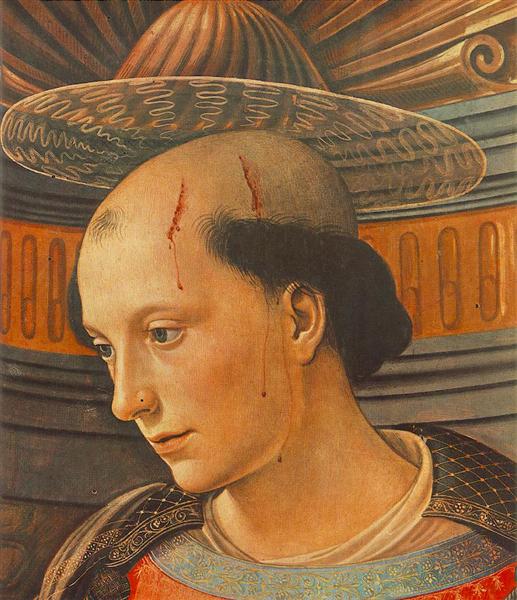 image – Domenico Ghirlandio,1494
image – Domenico Ghirlandio,1494
The Book ofActs says that Stephen was a man filled with grace and power, who worked great wonders among the people. Certain Jews, debated with Stephen but proved no match for the wisdom and spirit with which he spoke. They persuaded others to make the charge of blasphemy against him. He was seized and carried before the Sanhedrin. In his defense, Stephen recalled God’s guidance through Israel’s history, as well as Israel’s idolatry and disobedience. He then claimed that his persecutors were showing this same spirit. “You always oppose the holy Spirit; you are just like your ancestors”
His speech brought anger from the crowd. “But Stephen, filled with the holy Spirit, looked up intently to heaven and saw the glory of God and Jesus standing at the right hand of God, and he said, ‘Behold, I see the heavens opened and the Son of Man standing at the right hand of God….’ They threw him out of the city, and began to stone him…. As they were stoning Stephen, he called out, ‘Lord Jesus, receive my spirit…. Lord, do not hold this sin against them’”
St.Stephen is venerated as the first Christian Martyr and is the patron saint of Deacons and bricklayers.
Saint John of the Cross was a major figure of the Counter-Reformation, a Spanish mystic, a Roman Catholic saint, a Carmelite friar and a priest who was born at Fontiveros, Old Castile.
John of the Cross was a reformer in the Carmelite Order of his time and the movement he helped initiate, along with Saint Teresa of Ávila, eventually led to the establishment of the Discalced Carmelites, though neither he nor Teresa were alive when the two orders separated. He is also known for his writings. Both his poetry and his studies on the growth of the soul are considered the summit of mystical Spanish literature and one of the peaks of all Spanish literature. He was canonized as a saint in 1726 by Pope Benedict XIII. He is one of the thirty-six Doctors of the Church.
“In the year 1141…a fiery light, flashing intensely, came from the open vault of heaven and poured through my whole brain. Like a flame that is hot without burning, it kindled all my heart and all my breast, just as the sun warms anything on which its rays fall. And suddenly I could understand what such books as the Psalter, the Gospels and the other Catholic volumes both of the Old and New Testament actually set forth.” – Hildegard von Bingen
Pope Benedict spoke about Hildegard of Bingen during two of his general audiences in September 2010. He praised the humility with which she received God’s gifts and the obedience she gave Church authorities. He praised the “rich theological content” of her mystical visions that sum up the history of salvation from creation to the end of time. Pope Benedict said, “Let us always invoke the Holy Spirit, so that he may inspire in the Church holy and courageous women like St. Hildegard of Bingen, who, developing the gifts they have received from God, make their own special and valuable contribution to the spiritual development of our communities and of the Church in our time.”
Dying with Dignity: Read Bishop Henry’s letter in the Carillon for the month of November:
The full letter may be read HERE:
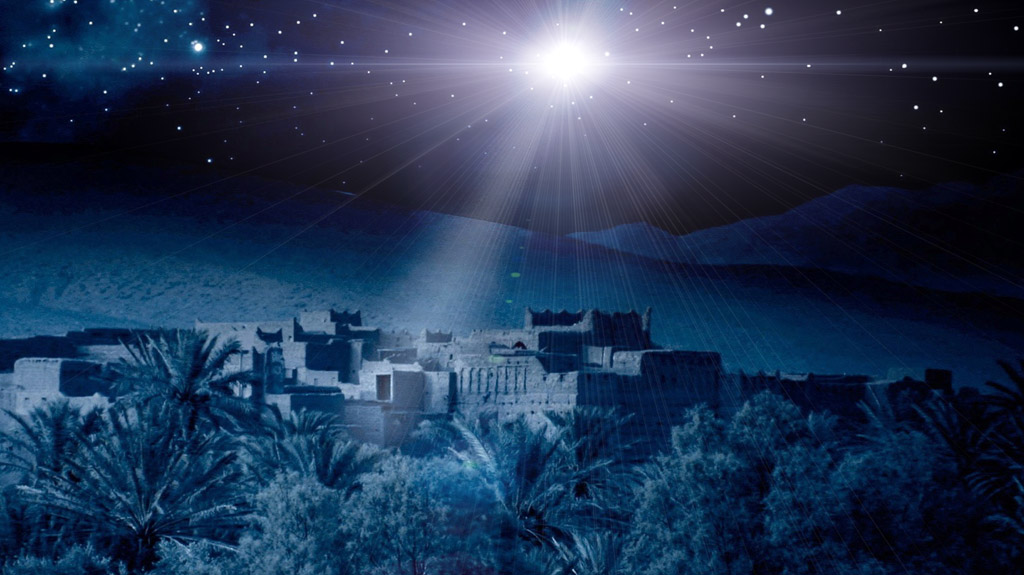 HAC – image – courtesy of and used with permission – www.freebibleimages.org – copyright LUMO Project
HAC – image – courtesy of and used with permission – www.freebibleimages.org – copyright LUMO Project
The Star of Bethlehem – have you ever wondered what it was or, what it would have looked like? Today, too many are quick to dismiss it as a nice story, or in the case of many secular scholars, a myth about Jesus’ birth that would parallel the older stories of the births of the pagan gods, in order to make the new religion more acceptable to the pagans. As something of an amateur astronomy buff, the Star has always fascinated me, especially as to what in the sky could have behaved as described in the Gospels. Recently I came across a book called “The Great Christ Comet” by Colin R. Nicholl, (PhD, University of Cambridge and professor of New Testament Studies at Gordon-Conwell Theological Seminary). In it, he analyzes the events described in the Gospels about the Star and the Magi, and then looks at the various astronomical theories that have arisen.
He concludes that the Star was a retrograde, narrowly inclined, long period comet, based on the following observations:
- Long period of visibility -This is demonstrated by the duration of the apparition and particularly how long prior to perihelion the comet first became visible to the naked eye, by the great size of the cometary coma shortly after perihelion when it was in the eastern sky, and by the length of its tail at that time and some weeks later when it stood over the house where Jesus was.
- Narrow inclination. The comet was narrowly inclined to the ecliptic and probably orbited within the zodiacal band, rendering it of more astrological significance to the Magi. Among other things, that the comet set with its tail stretching upwards, when the Magi were in Bethlehem, is suggestive of narrow inclination. Narrowly inclined comets sport relatively straight dust tails, from Earth’s perspective, as opposed to the more curved dust tails of steeply inclined comets.
- Retrograde. The comet was unquestionably retrograde (moving in a clockwise direction, from the vantage point of the north pole). This is indicated by the fact that it increased in size within Virgo and, having left the eastern sky, quickly progressed to the southern evening sky.
- Heliacal rising. The Magi saw the cometary coma rise heliacally in the eastern sky, meaning that it had been in conjunction with the Sun prior to its reappearance. The retrograde comet was emerging from the Sun around the time of perihelion (when a comet’s brightness peaks). During this time the coma was an especially bright morning star and was observable in the northern hemisphere (specifically in the Near East). The comet as a whole probably looked like a scepter at this time.
- Notable apparent magnitude. Since dim comets would not be visible low on the horizon at sunrise or remain observable when very large, and since this comet is regarded as a great light shining into the deep darkness, the Christ Comet must have had extraordinary apparent magnitude values. It was probably a daylight object around perihelion.
- From Babylon to Jerusalem. Having witnessed the entire celestial nativity drama, the Magi no doubt soon began their journey to Judea. The comet, having switched quickly from the morning to the evening/night sky, probably remained visible to them throughout their journey. It is likely that, every night, the comet moved toward and over the western horizon, seeming to urge them onward to Jerusalem.
- Very much like Comet Hale-Bopp – The fact that the Christ Comet was seen by the naked eye so long before perihelion is reminiscent of C/1995 O1 (Hale-Bopp). Hale-Bopp was first seen 10½ months before perihelion, when it was still 4.37 AU from the Sun. It has been calculated that Hale-Bopp started forming its coma roughly 18 AU from the Sun.25 The Bethlehem Star comet was first observed on or before December 10–17, 7 BC, about 9½ months before perihelion, when it was 4.71–4.63 AU from the Sun. Its coma probably began to form out beyond the orbit of Uranus (20 AU from the Sun). Comets such as Hale-Bopp and the Magi’s Star begin degassing so long before perihelion because they contain relatively high volumes of extremely volatile materials such as nitrogen, carbon monoxide, and methane.26 These materials begin reacting to the Sun at long distances from the Sun, whereas water-ice begins to degas only when within 3 AU.27
Indeed, if one looks at photos of Hale-Bopp, such as this one I took, one can see how the tail would have looked like a scepter or pointer.
I would tend to agree with Dr.Nicholl, in that the most logical explanation for the Star is a comet.
One other point of note – there is a Roman coin from the province of Antioch that dates from around 6 AD. It shows a ram looking over its shoulder at a “star”.
Dr. Michael Molnar, a Christian astronomer, published “The Star of Bethlehem-The Legacy of the Magi.” His findings included the meaning behind the “Ram and Star” coins from Antioch.Dr.Molnar concluded that the design was meant to recognize the birth of the Messiah in Judaea and that His birth occurred on April 17, 6 BC,based on an unusual array of the planets occurred in Aries during 6 BC. Aries had long been recognized as the astrological symbol for Judea. This alignment also corresponds with the scriptural reference to the Star rising in the East, which would have been very significant the the Magi, who were, in all likelihood Babylonian priest-astronomers, tasked with observing and recording the stars with an intent to interpret events, present and future.
HAC for St.Bernard’s Parish.
In an article at Swords of Truth, Fr.Nathan talks about St.Charles Borromeo, and the relic of him that we have at St.Bernard’s Church.
“Church sacristies (the room where everything needed for the celebration of the Holy Mass is kept) can become the dumping ground of many decades of liturgical vestments, altar linens and countless other items. Some are of exquisite quality, while others are in need of being thrown into a liturgical bonfire! If a priest or sacristan takes the time to periodically give the sacristy a decent cleaning, then every so often he may come across an unexpected treasure. Such was the case when I was cleaning out a drawer and found a small metal case that contained the relic of a saint. Upon closer inspection, I learned that it was a relic of St Charles Borromeo, with the intials E.C. written beneath. This is an abbreviation for the Latin phrase ex corpore, which means that the relic is a piece of the flesh of the saintly 16th century Cardinal Archbishop of Milan.”
Read the complete article HERE:
“We do not worship, we do not adore, for fear that we should bow down to the creature rather than to the Creator, but we venerate the relics of the martyrs in order the better to adore Him whose martyrs they are. We honour the servants in order that the respect paid to them may be reflected back to the Lord. If the Apostles and martyrs, while still living on earth, could pray for other men, how much more may they do it after their victories? Have they less power now that they are with Jesus Christ?”
St. Jerome, Doctor of the Church, 331-420 A.D.


